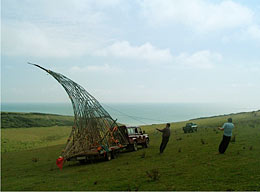Wild structures of the land

Outcrop, 2001. Sycamore and wheat, Ditchling Southdowns
Brighton based Red Earth, are known for their performances in and on the land. Since the turn of the century, they've also been integrating sculptural structures into these performances, both centre stage and part of the larger performance moments
Here Red Earth's Simon Pascoe and Caitlin Easterby discuss these structural-sculptural elements of their work
Our work in greenwood began in earnest with OUTCROP (2001). I can't remember now which came first, the material or the drawing, but , the series of waveforms created between 2001 and 2008, OUTCROP (2001), Vanishing Point (Geograph, 2005) and Storm Surge (Long Shore Drift, 2008) were effectively three-dimensional renditions of linear drawings. For me working with lengths of greenwood is an extension of the drawing process, and one I can understand: I consider myself a linear artist rather than a sculptor, but in 3D, the strong lines of the young trees are like powerful, physicalised brush strokes.
Working with greenwood, playing tension off against force, is a very strenuous activity, and the whole process demands a good deal of physical effort. I love these qualities of tension and flexibility you only find in greenwood and which, when applied well, lead to a real expression of energy. We try to keep lengths to a maximum, allowing the wood itself to find expression as part of a form, which, in its totality, strengthens the impression of vigour, movement and growth inherent in living wood.

Making Outcrop
Once conscious of the nice play our work created between traditional practice and contemporary art, we extended this use of craft in Vanishing Point, with the addition of a traditional lime-washed wattle and daub section to the structures.
The two installations in CHALK (2011)
River and Fold, were our first significant greenwood installations since 2008. Built very much as a response to place – Harting Down - we used our understanding of traditional building to explore both the meaning of place and the materials we were using. In River two hazel fences were distorted, stretched and extended, built with a focus on manifesting a sense of movement, muscularity and freedom, beginning with tight-knit integrated weaving, ending with a wide open and fast flowing structural form. Fold, in effect a 9m wide woven bowl, pushed the dimensionality of the craft to create a solid yet sweeping circular wall of running greenwood.
Simon Pascoe July 2012

Storm Surge

CHALK installation

CHALK installation and 2011, Harting Down and
Wolstonbury Hill National Trust
Wolstonbury Hill National Trust
We made our first waveform sculptures whilst researching The Field, a project with Common Ground to celebrate the distinctive nature of the English agricultural landscape. Sitting in a crop filled barn hand-stitching lengths of ripe golden wheat onto a coppiced hazel frame I was struck by the synergy between the rhythms of the agricultural year and our artistic process. For practical reasons ten of us had to hand scythe the wheat as a combine would have yielded only short mangled lengths. The scything had something of the communal harvest about it: hard work, camaraderie and celebration on a hot summer’s day. Could this energy - a lost connection to land, communal celebration with work at its centre and the slow rhythms of making things by hand – be harnessed into a Red Earth project on the Downs? As I spent my days hand stitching thousands of wheat stems together with a sail needle, ideas for OUTCROP germinated. In 2001 I was stitching again in one of the hottest summers on record, this time using huge needles specially made by a blacksmith to transform half an acre of Sussex barley into a sweeping dynamic thatch for the three twelve foot high greenwood wave forms which comprised our highly visible OUTCROP installation perched on a South Downs chalk ridge above Ditchling.

CHALK

GEOGRAPH 2005: Vanishing Point. Sycamore, hazel, chalk,dung,
straw. Birling Gap National Trust
straw. Birling Gap National Trust
Red Earth’s work is informed by the processes, some dying and others undergoing a current welcome revival, of woodland and agricultural life. We employ them for a contemporary sculptural purpose, installations are firmly rooted in the Land Art tradition. Sculptures evoke the techniques of rural craft and vernacular building but are not attempts at historical authenticity just as our performance journeys through the landscapes in which structures are sited are not in any way historical re-enactments or ‘authentic’ ritual. We will use a tractor, an auger, a crane lift or a chain saw if necessary – they are the tools of modern agriculture and forestry, they get the work made.

Long Shore Drift Storm Surge installation

Making Long Shore Drift Storm Surge installation
Caitlin Easterby July 2012
Simon and Caitlin can be contacted here contact@redearth.co.uk
All images: Red Earth